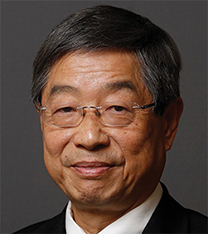Tsin, a mentor to many, advances diversity
, at the University of Texas Rio Grande Valley School of Medicine, has won the 2018 . The ┬ķČ╣┤½├Į╔½ŪķŲ¼ and ┬ķČ╣┤½├Į╔½ŪķŲ¼ Biology’s Minority Affairs Committee selects the winner of this award to recognize an outstanding scientist who has contributed significantly to increasing the participation of minorities in science.

“I have worked with Dr. Ruth Kirschstein for many years on NIH minority programs. I am very honored to receive this ASBMB award named after my esteemed colleague. To continue Dr. Kirschstein’s outstanding accomplishments in diversity initiatives, I will remain professionally and personally committed to increase diversity in science.”
— Andrew Tsin
Tsin, an expert in retinal neurobiology, has done notable work on the biochemistry of the visual cycle throughout his career. His prolific contributions to science have resulted in more than 300 journal articles, book chapters and meeting presentations. His research has been recognized with numerous awards, such as the 2015 Gold Fellow Award by the Association for Research in Vision and Ophthalmology.
Tsin also is known as a scientific mentor who has contributed to the advancement of diversity in science. Robert Renthal, professor of biochemistry at the University of Texas at San Antonio, wrote in his nomination letter that Tsin “has an unusual ability to inspire students who are members of groups that are underrepresented in the sciences to successfully pursue careers in science” and that Tsin has “worked tirelessly, one-on-one, with research trainees in his lab, sustained over a period of more than 30 years.” Tsin has mentored 132 graduate and undergraduate students, including 112 members of groups underrepresented in the sciences. Of these, 20 have earned a Ph.D. in the sciences and 12 have earned an M.D. or D.D.S. Tsin’s mentoring also resulted in numerous journal publications with student first authors, Renthal wrote.
Tsin’s legacy of effectively increasing diversity in science goes beyond the walls of his lab. While at UTSA, where he spent most of his career before moving to UTRGV in 2016, he founded and directed the , securing more than $52 million in grants to support research and training programs for underrepresented minorities. Additionally, he served on the board of directors of the from 2007 to 2009. Tsin’s contributions to the advancement of minorities in science earned him the for Excellence in Science, Mathematics and Engineering Mentoring in 2011 and a Lifetime Achievement Award from the American Association for the Advancement of Science in 2014.
of the University of Colorado Anschutz Medical Campus, chair of the ASBMB Minority Affairs Committee, said, “Dr. Tsin has all the necessary attributes that Dr. Ruth Kirschstein championed during her career: compassion, empathy, service, and dedication to diversity in science while maintaining a rigorous and exceptional research career.”
Enjoy reading ASBMB Today?
Become a member to receive the print edition four times a year and the digital edition monthly.
Learn moreGet the latest from ASBMB Today
Enter your email address, and weŌĆÖll send you a weekly email with recent articles, interviews and more.
Latest in People
People highlights or most popular articles

In memoriam: David Baltimore
He was a Nobel laureate, president emeritus at the California Institute of Technology and an ASBMB member for more than 50 years.

In memoriam: Stuart A. Kornfeld
He was a pioneer in glycobiology and was a member of the ┬ķČ╣┤½├Į╔½ŪķŲ¼ and ┬ķČ╣┤½├Į╔½ŪķŲ¼ Biology for more than 50 years.

Top reviewers at ASBMB journals
Editors recognize the heavy-lifters and rising stars during Peer Review Week.

CedeñoŌĆōRosario and Kaweesa win research award
The award honors outstanding early-career scientists studying cancer, infectious disease and basic science.

ASBMB names 2026 award winners
Check out their lectures at the annual meeting in March in the Washington, D.C., metro area.

Peer through a window to the future of science
Aaron Hoskins of the University of WisconsinŌĆōMadison and Sandra Gabelli of Merck, co-chairs of the 2026 ASBMB annual meeting, to be held March 7ŌĆō10, explain how this gathering will inspire new ideas and drive progress in molecular life sciences.

